英文跨文化交际课件[优质ppt]
合集下载
跨文化交际上课ppt3.
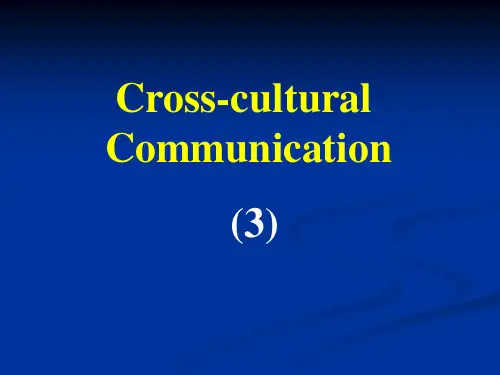
• The Chinese laugh • The Japanese smile
Eye contact
Western norm eye contact Black’s norm for eye contact
Clothing
Functions of clothing ---for protection ---for modesty ---for display of a type of culture
Space
Different attitude towards crowding • To use one’s hands to get through a crowd • To use one’s body to get through a crowd
Space
• Use of space in the office • Location of office to indicate rank • Difference in office arrangement • Ma culture in Japan e.g. flower arrangement
Intimate distance
No distance to 6-8 inches
Personal distance
1.5-2.5 feet to 2.5-4 feet
Social distance
4-7 feet to 7-12 feet
Public distance
12-25 feet
Clothing-dress code
---Dress code specified for occasions ---Dress code specified for institutions ---Dress code specified for professions
Eye contact
Western norm eye contact Black’s norm for eye contact
Clothing
Functions of clothing ---for protection ---for modesty ---for display of a type of culture
Space
Different attitude towards crowding • To use one’s hands to get through a crowd • To use one’s body to get through a crowd
Space
• Use of space in the office • Location of office to indicate rank • Difference in office arrangement • Ma culture in Japan e.g. flower arrangement
Intimate distance
No distance to 6-8 inches
Personal distance
1.5-2.5 feet to 2.5-4 feet
Social distance
4-7 feet to 7-12 feet
Public distance
12-25 feet
Clothing-dress code
---Dress code specified for occasions ---Dress code specified for institutions ---Dress code specified for professions
cultural-diversity-跨文化交际PPT课件
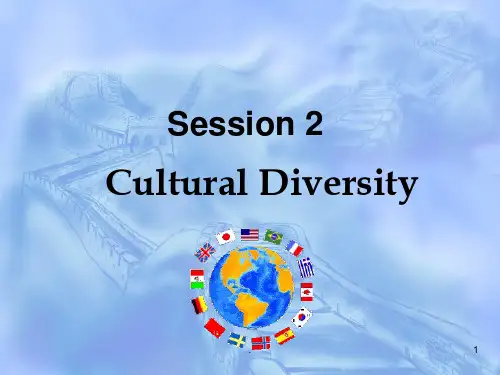
Kluckhohn and Strodtbeck’s Hofstede’s Dimensions Edward T Hall’s
Value Orientation
of Cultural Variability
Context - Culture Theory
Human Nature Man-nature
(10 mins)
.
17
2. Model by G. Hofstede (1984)
▪ Hofstede’s work was one of the earliest attempts to use extensive statistical data to examine cultural values.
rules and guideposts)
.
6
Why is one culture different from
another?
More deeply
▪ World view (religion)
- Spiritual and psychological needs of people (life and death, creation of universe, relationship between humans and nature)
1) = Human nature orientation 人性取向
2) = Man-nature orientation 人天取向
3) = Time orientation
时间取向
4) = Activity orientation
行为取向
5) = Social orientation
. 人际取向
英文跨文化交际精PPT课件
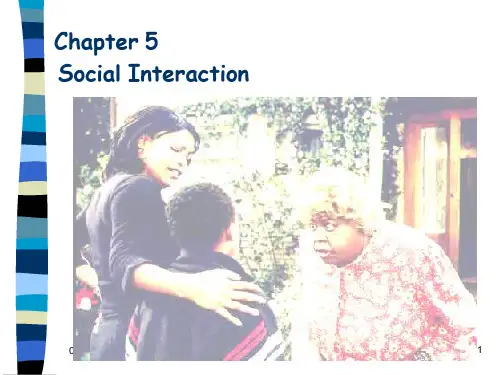
Susan: Thank you! The same to you.
Husband’s translation: 谢谢妈妈,我祝您身体健康。
Mother: 谢谢,谢谢。
01.05.2020
.
7
Activity 1 Forms of address
Doctor, Professor, Judge, Preseident, Senator, Governer, Mayor, Colonel, Captain, etc.
.
2
By the end of this chapter, you should be able to:
1. have a better understanding of the conventions and expectations of different cultures in areas such as:
.
2. be more aware of your own behavior patterns and how they are shaped by Chinese culture.
3. know how to avoid or lessen misunderstanding in intercultural communication and be able to convey your ideas more successfully.
C. We Chinese routinely use many position-linked or
occupation-linked titles to address people, such as wang
jinling (王经理), ma juzhang (马局长), zhang zhuren (张主
CrossCulturalCommunicationUnit14跨文化交际精品PPT课件
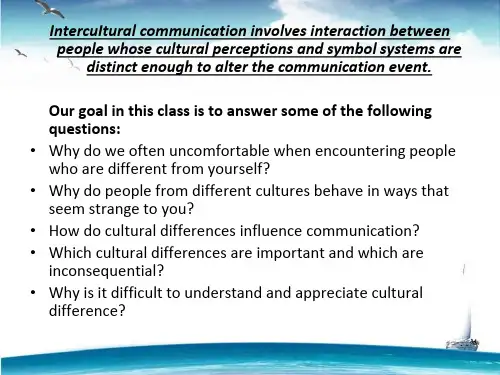
Our goal in this class is to answer some of the following questions: • Why do we often uncomfortable when encountering people who are different from yourself? • Why do people from different cultures behave in ways that seem strange to you? • How do cultural differences influence communication? • Which cultural differences are important and which are inconsequential? • Why is it difficult to understand and appreciate cultural difference?
– This is called Globalization.
– Globalization has greatly increased the economic strength of many nations and bring people together from different cultures. However, it could resulting more competition for natural resources, international conflicts and security, environmental issues, and world health issues.
CHAPTER 1 - Communication and Culture: The Challenge of The Future
– This is called Globalization.
– Globalization has greatly increased the economic strength of many nations and bring people together from different cultures. However, it could resulting more competition for natural resources, international conflicts and security, environmental issues, and world health issues.
CHAPTER 1 - Communication and Culture: The Challenge of The Future
跨文化交际(英文PPT)

the issues concerning intercultural communication .
III. Plan.
1.Required Textbook :Communication Between Cultures (Third Edition)By Larry A. Samovar Richard E. Porter Lisa A. Stefani 2000 2. Time schedule: 36 periods in one term. 1).Introduction to Intercultural Communication ;4periods 2).Part I Communication and Culture; 8 periods 3).Part II The Influence of Culture ; 8 periods 4).Part III From Theory of Practice; 8 periods 5).Part IV Knowledge into Action; 8 periods 3. Evaluation will be based on: 1)Attendance and participation. 2)Project presentation and handout (the required essay ). 3)Final examination.
The book is divided into four interrelated parts, including 10 chapters: (Look at P.F28)
Part I introduces the study of communication and culture(Chapter1-2);
III. Plan.
1.Required Textbook :Communication Between Cultures (Third Edition)By Larry A. Samovar Richard E. Porter Lisa A. Stefani 2000 2. Time schedule: 36 periods in one term. 1).Introduction to Intercultural Communication ;4periods 2).Part I Communication and Culture; 8 periods 3).Part II The Influence of Culture ; 8 periods 4).Part III From Theory of Practice; 8 periods 5).Part IV Knowledge into Action; 8 periods 3. Evaluation will be based on: 1)Attendance and participation. 2)Project presentation and handout (the required essay ). 3)Final examination.
The book is divided into four interrelated parts, including 10 chapters: (Look at P.F28)
Part I introduces the study of communication and culture(Chapter1-2);
跨文化交际Nonverbal Communication ppt课件
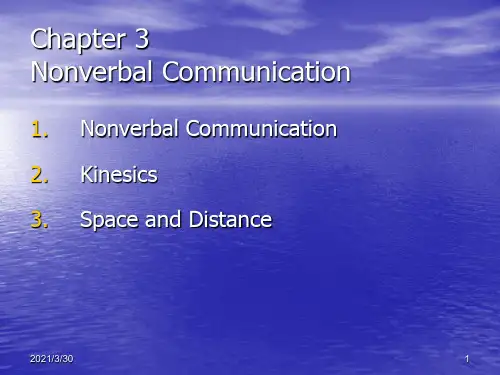
• Personal Distance (45-120cm) - friends, old classmates, acquaintance and relatives
2021/3/30
29
Categories of Distance (cont’d)
• Social Distance (1.3-3m) - colleagues, business partners, people at social gatherings
• Australia and Nigeria - up yours
• Some Asian and Islamic countries - rude and offensive
2021/3/30
17
The Thumb Down Sign
• Sth is bad or sth you do not approve of. • Sth or someone has failed. • Not used as often as the thumbs up sign. It is a
✓ Four categories: intimate, personal, social, and public distance.
2021/3/30
28
Categories of Distance
• Intimate Distance (0-45cm) - for the closest relation, e.g. a couple
• May damage your image if you neglect your postures
2021/3/30
23
2.4 Eye Contact
Direct eye contact • Chinese: avoid • North Americans: appreciate • The British: avoid
2021/3/30
29
Categories of Distance (cont’d)
• Social Distance (1.3-3m) - colleagues, business partners, people at social gatherings
• Australia and Nigeria - up yours
• Some Asian and Islamic countries - rude and offensive
2021/3/30
17
The Thumb Down Sign
• Sth is bad or sth you do not approve of. • Sth or someone has failed. • Not used as often as the thumbs up sign. It is a
✓ Four categories: intimate, personal, social, and public distance.
2021/3/30
28
Categories of Distance
• Intimate Distance (0-45cm) - for the closest relation, e.g. a couple
• May damage your image if you neglect your postures
2021/3/30
23
2.4 Eye Contact
Direct eye contact • Chinese: avoid • North Americans: appreciate • The British: avoid
跨文化交际 英文PPT课件
胡文仲主编 《跨文化交际丛书》 外语教学研究出版社
▪ 胡文仲《跨文化交际概论》
▪ 杜学增《中英(英语国家)文化习俗比较》
▪平洪&张国扬《英语习语与英美文化》
▪ 毕继万《跨文化非言语交际》
▪ 王克非《从翻译史看文化差异》
▪ 朱永涛《美国价值观---一个中国. 学者的探讨
2
Further Reading
.
1
Further Reading
▪ 林大津《跨文化交际学:理论与实践》,福建人民出版社
▪“Communication Between Cultures”(美)萨莫瓦等著,陈治 安导读
▪ 《中国和英语国家非语言交际对比》Leger Brosnahan 著,
毕继万译,北京语言学院出版社
《 语言研究的跨文化视野》 许力生著,上海外语教育出版社
different for all of us. It is these different experiences
that make up what is called “culture” in the social
sciences - the habits of everyday life, the cues to
An Introduction”, then answer the following
questions.
1. Is it still often the case that “everyone’s quick to blame the alien”
in the contemporary world? 2. What’s the difference between today’s intercultural contact and
英文版跨文化交际PPT课件
east&west
12/14/2019
1
1.gift
This is the American way to open gifts, they usually opened directly after dinner received a gift. Directly express their own joy.
wedding vows in the
church.Couples pay worship to be
2019/12/14
10
WOW!!。。。。。
2019/12/14
11
额。。。。。。。
2019/12/14
12
虽然每一种文化都有自己的社会做法。但是每一个 人都是独特的不同的,每个人都可以选择自己喜欢 的做法。
2019/12/14
9
wedding ceremony
• 东西方文化中不同的婚礼以仪式。西方文化中婚礼要在教堂中许下誓 言。在中国要进行夫妻交拜。
• Eastern and Western cultures,
different wedding
ceremony.Western culture in the
But, in China, gifts are never opened in front of giver, and doing so is considered
bad manners. So people had to hide his feelings .
这是社会做法的外在表现的一方面。 This is the the outward manifestations aspect of social practices
12/14/2019
1
1.gift
This is the American way to open gifts, they usually opened directly after dinner received a gift. Directly express their own joy.
wedding vows in the
church.Couples pay worship to be
2019/12/14
10
WOW!!。。。。。
2019/12/14
11
额。。。。。。。
2019/12/14
12
虽然每一种文化都有自己的社会做法。但是每一个 人都是独特的不同的,每个人都可以选择自己喜欢 的做法。
2019/12/14
9
wedding ceremony
• 东西方文化中不同的婚礼以仪式。西方文化中婚礼要在教堂中许下誓 言。在中国要进行夫妻交拜。
• Eastern and Western cultures,
different wedding
ceremony.Western culture in the
But, in China, gifts are never opened in front of giver, and doing so is considered
bad manners. So people had to hide his feelings .
这是社会做法的外在表现的一方面。 This is the the outward manifestations aspect of social practices
Intercultural--CommunicationPPT优秀课件
cultural Communication in Action
2
❖窦卫林《跨文化商务交际 Intercultural Business Communication》
❖ 关世杰《跨文化交流学》
3
Course Description:
This course is about intercultural communication. The nature of intercultural communication should be specified and we have to recognize that people who hold various viewpoints see it somewhat differently. Intercultural communication can be explored in a variety of ways.
9
the habits of everyday life, the cues to which people respond, the automatic reactions they have to whatever they see and hear. These often differ, and the differences may introduce misunderstandings where we seek understanding. More examples:
❖5. To develop an awareness of contemporary events that illustrate the need for improved intercultural communication skills.
2
❖窦卫林《跨文化商务交际 Intercultural Business Communication》
❖ 关世杰《跨文化交流学》
3
Course Description:
This course is about intercultural communication. The nature of intercultural communication should be specified and we have to recognize that people who hold various viewpoints see it somewhat differently. Intercultural communication can be explored in a variety of ways.
9
the habits of everyday life, the cues to which people respond, the automatic reactions they have to whatever they see and hear. These often differ, and the differences may introduce misunderstandings where we seek understanding. More examples:
❖5. To develop an awareness of contemporary events that illustrate the need for improved intercultural communication skills.
Cultural-Patterns跨文化交际的文化模式PPT课件
3.2.1 High-Context
A high context (HC) communication or message is one in which most of the information is already in the person, while very little is in the coded, explicitly transmitted part of the message. In high-context cultures, people are very homogeneous with regard to experiences, information networks, and the like. High-context cultures, because of tradition and history, change very little over time.
3.1.3 Power Distance
The premise of the dimension deals with the extent to which a society accepts that power in relationships, institution, and organizations is distributed unequally. People in high-power-distance countries believe that power and authority are facts of life…Social hierarchy is prevalent and institutionalizes inequality. To people in low-power-distance countries, a hierarchy is an inequality of roles established for convenience.
- 1、下载文档前请自行甄别文档内容的完整性,平台不提供额外的编辑、内容补充、找答案等附加服务。
- 2、"仅部分预览"的文档,不可在线预览部分如存在完整性等问题,可反馈申请退款(可完整预览的文档不适用该条件!)。
- 3、如文档侵犯您的权益,请联系客服反馈,我们会尽快为您处理(人工客服工作时间:9:00-18:30)。
SocialInteraction
2020/10/3
1
2020/10/3
Role – behavior expected of someone who holds a particular status
Role set – a number of roles attached to a single status
B. In China we address a stranger with an advanced age
"Grandpa" or "Grandma". Why do we do so since that stranger is not connected to us by blood? How does this sound to an English ear?
Susan: Yes, oh thanks for your delicious food, I like them very much.
Husband’s translation: 谢谢妈妈给我们做了那么多好
吃的。
Mother: 自家人谢什么,苏珊,你以后可不要再减肥了,
身体健康才最重要哪!
Husband’s translation: It’s my pleasure, Susan, I hope you become even more beautiful.
2
By the end of this chapter, you should be able to:
1. have a better understanding of the conventions and expectations of different cultures in areas such as:
• Forms of address • Greetings • Farewells • Complimenting and responding • Inviting • Paying for a meal • Showing hospitality • Disagreeing, etc.
2020/10/3
任), li yisheng (李医生) , etc. Do Americans have similar
customs?
2020/10/3
5
Case study
A Situation: What to say
E.G. A conversation between Susan and Mrs. Zhang, her mother-in-law, at the airport when leaving China. The husband is interpreting for them.
Susan: Thank you! The same to you.
Husband’s translation: 谢谢妈妈,我祝您身体健康。
Mother: 谢谢,谢谢。
2020/10/3
7
Activity 1 Forms of address
Doctor, Professor, Judge, Preseident, Senator, Governer, Mayor, Colonel, Captain, etc.
C. We Chinese routinely use many position-linked or
occupation-linked titles to address people, such as wang
jinling (王经理), ma juzhang (马局长), zhang zhuren (张主
2020/10/3
4
Activity 1 Forms of address
A. The young lady Marilyn in America addresses her
mother-in-law by her first name, Ellen. How do you account for this? Could the same thing happen in China? Why?
3
2. be more aware of your own behavior patterns and how they are shaped by Chinese culture.
3. know how to avoid or lessen misunderstanding in intercultural communication and be able to convey your ideas more successfully.
Chinese culture is relation-oriented. Maintaining or promoting relation calls for something interpersonal, so it is quite acceptable in China to greet each other by asking private questions, while English people have a very strong sense of privacy.
2020/10/3
பைடு நூலகம்
6
Susan: Mrs. Zhang, come to New York if you want.
Husband’s translation: 妈妈,您可一定要来纽约看看。 Mother: 不去了,给你们添麻烦。
Husband’s translation: Oh, it depends on the physical condition.
2020/10/3
8
Activity 2 Greetings
Work in pairs. List some common forms of greeting among the English-speaking people and Chinese people. then try to spot some differences, if there are any.
2020/10/3
1
2020/10/3
Role – behavior expected of someone who holds a particular status
Role set – a number of roles attached to a single status
B. In China we address a stranger with an advanced age
"Grandpa" or "Grandma". Why do we do so since that stranger is not connected to us by blood? How does this sound to an English ear?
Susan: Yes, oh thanks for your delicious food, I like them very much.
Husband’s translation: 谢谢妈妈给我们做了那么多好
吃的。
Mother: 自家人谢什么,苏珊,你以后可不要再减肥了,
身体健康才最重要哪!
Husband’s translation: It’s my pleasure, Susan, I hope you become even more beautiful.
2
By the end of this chapter, you should be able to:
1. have a better understanding of the conventions and expectations of different cultures in areas such as:
• Forms of address • Greetings • Farewells • Complimenting and responding • Inviting • Paying for a meal • Showing hospitality • Disagreeing, etc.
2020/10/3
任), li yisheng (李医生) , etc. Do Americans have similar
customs?
2020/10/3
5
Case study
A Situation: What to say
E.G. A conversation between Susan and Mrs. Zhang, her mother-in-law, at the airport when leaving China. The husband is interpreting for them.
Susan: Thank you! The same to you.
Husband’s translation: 谢谢妈妈,我祝您身体健康。
Mother: 谢谢,谢谢。
2020/10/3
7
Activity 1 Forms of address
Doctor, Professor, Judge, Preseident, Senator, Governer, Mayor, Colonel, Captain, etc.
C. We Chinese routinely use many position-linked or
occupation-linked titles to address people, such as wang
jinling (王经理), ma juzhang (马局长), zhang zhuren (张主
2020/10/3
4
Activity 1 Forms of address
A. The young lady Marilyn in America addresses her
mother-in-law by her first name, Ellen. How do you account for this? Could the same thing happen in China? Why?
3
2. be more aware of your own behavior patterns and how they are shaped by Chinese culture.
3. know how to avoid or lessen misunderstanding in intercultural communication and be able to convey your ideas more successfully.
Chinese culture is relation-oriented. Maintaining or promoting relation calls for something interpersonal, so it is quite acceptable in China to greet each other by asking private questions, while English people have a very strong sense of privacy.
2020/10/3
பைடு நூலகம்
6
Susan: Mrs. Zhang, come to New York if you want.
Husband’s translation: 妈妈,您可一定要来纽约看看。 Mother: 不去了,给你们添麻烦。
Husband’s translation: Oh, it depends on the physical condition.
2020/10/3
8
Activity 2 Greetings
Work in pairs. List some common forms of greeting among the English-speaking people and Chinese people. then try to spot some differences, if there are any.
